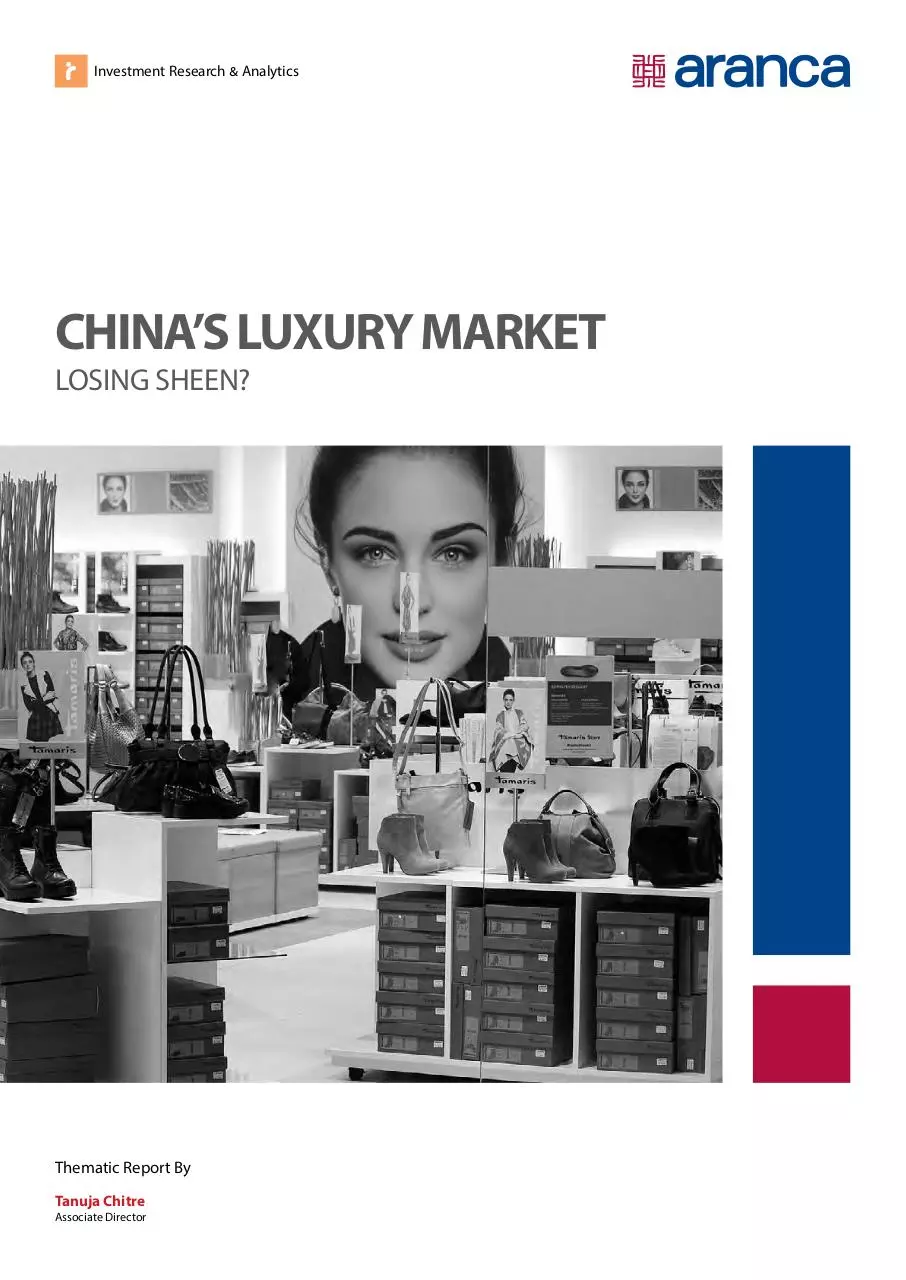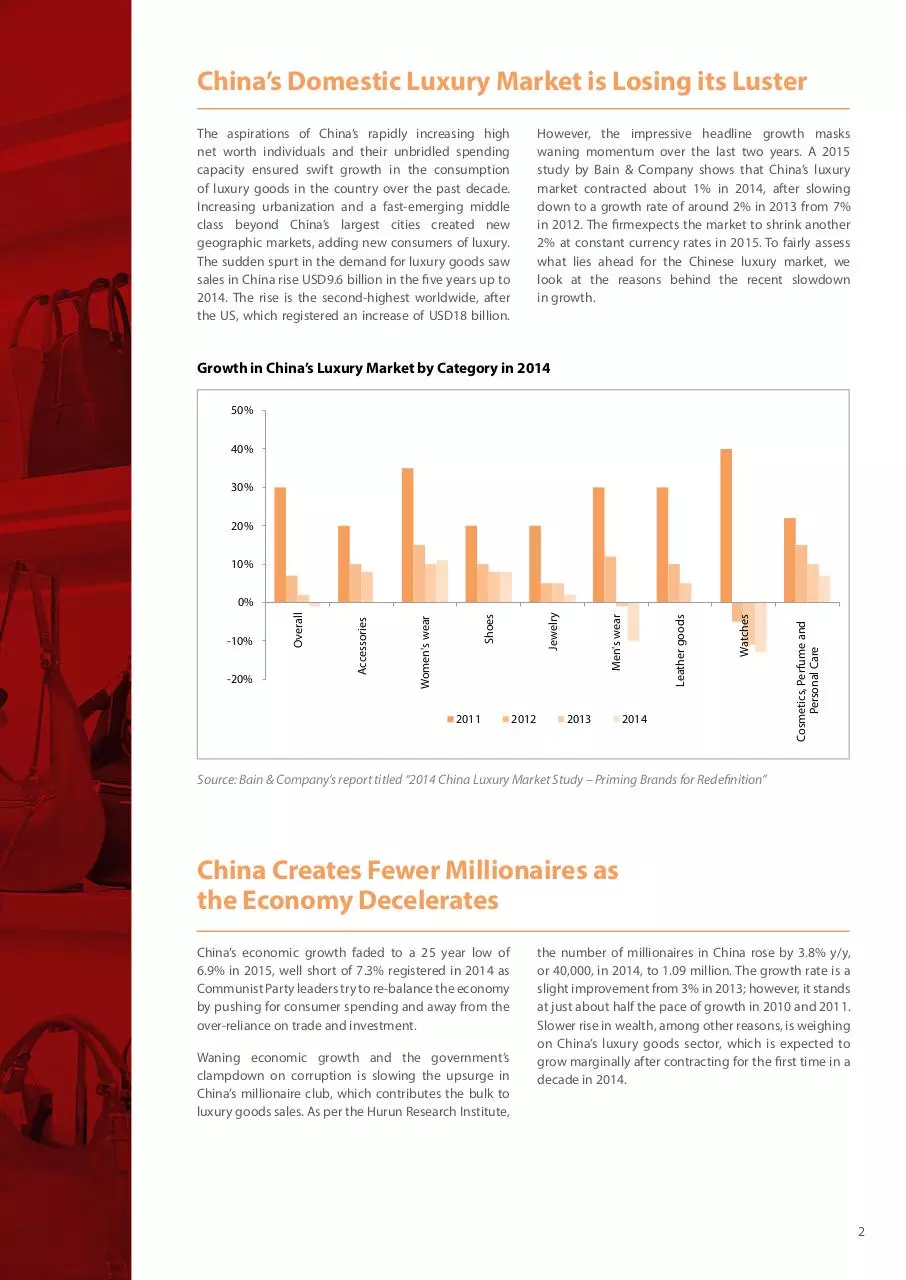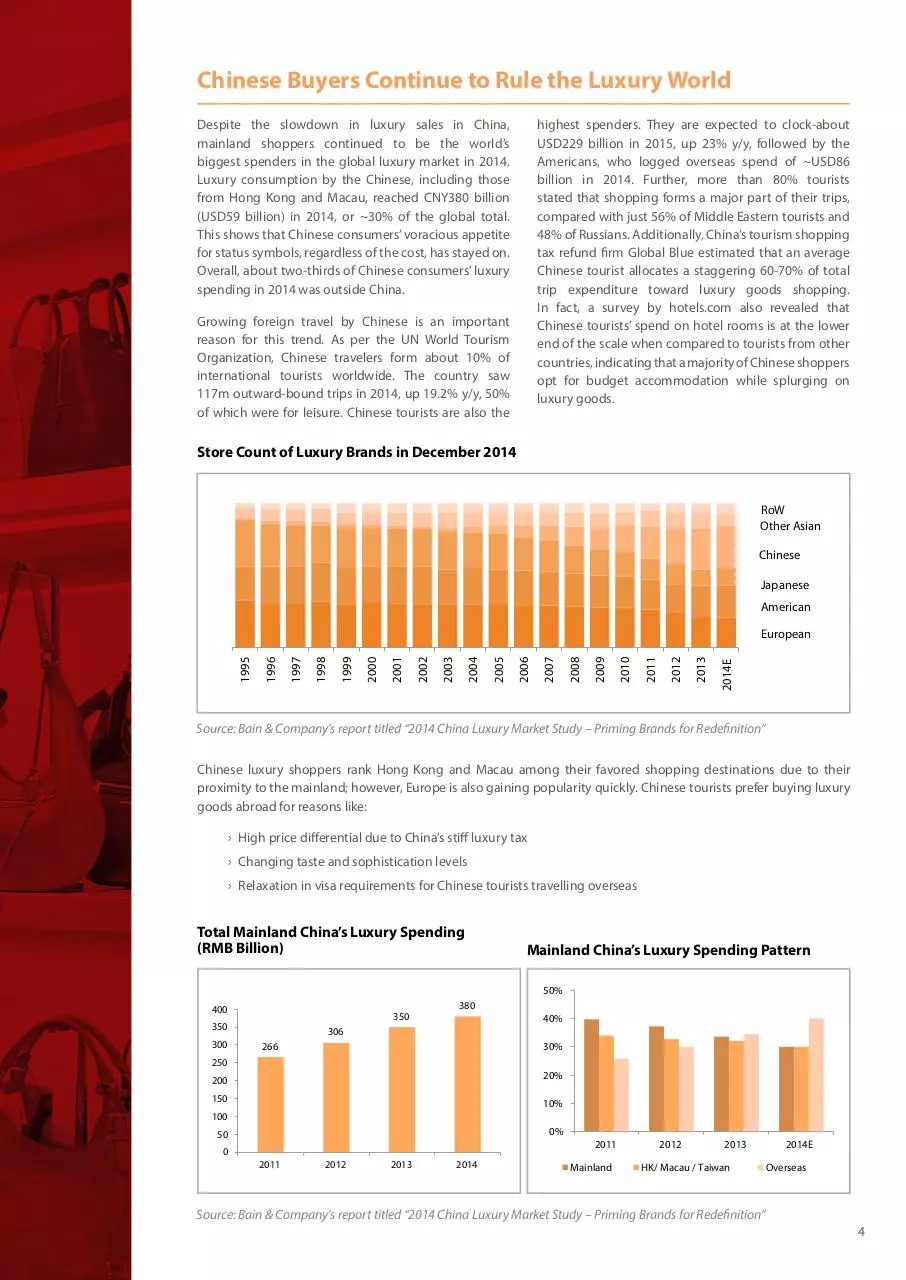Chinas Luxury Market Losing Sheen (PDF)
File information
This PDF 1.7 document has been generated by Adobe InDesign CC 2015 (Windows) / Adobe PDF Library 15.0, and has been sent on pdf-archive.com on 27/01/2017 at 09:57, from IP address 103.224.x.x.
The current document download page has been viewed 561 times.
File size: 1.48 MB (8 pages).
Privacy: public file





File preview
Investment Research & Analytics
CHINA’S LUXURY MARKET
LOSING SHEEN?
Thematic Report By
Tanuja Chitre
Associate Director
IS CHINA’S SLOWDOWN TAKING
THE SHEEN OFF LUXURY GOODS?
Wealthy consumers in China have significantly slowed the pace of purchasing luxury
handbags and watches in the mainland, raising concerns that China’s love for luxury
may be cooling.
China’s current economic slowdown has dragged the growth rate of the country’s millionaire
club. The number of millionaires grew a mere 3.8% in 2014, sharply slower than the 9.7%
growth recorded in 2011.
President Xi Jinping’s vast anti-corruption campaign and heavy public scrutiny are quashing
the country’s graft-by-gift-giving culture.
The Chinese yuan’s surprise devaluation is expected to dull sales of luxury goods further.
However, the crackdown and the devaluation have not entirely discouraged spending.
Chinese consumers are now purchasing more luxury goods abroad, with more than ~70% of
their luxury goods purchases outside of the country.
Hefty import tariffs and consumption taxes, and growing sophistication, along with
Chinese consumers’ penchant for overseas travel, are driving luxury goods sales abroad. In
response, luxury brands are slowing down their expansion plans in China, with Louis Vuitton
announcing store closures (November 2015) in an attempt to avoid overexposure. A trend
fast catching up in China is purchasing affordable or accessible luxury.
The rise of the category is driven by burgeoning middle classes as well as high income
individuals looking for understated merchandize. Overall, the heady days of 20% growth may
be over, but China’s affinity to luxury merchandise persists.
1
China’s Domestic Luxury Market is Losing its Luster
However, the impressive headline growth masks
waning momentum over the last two years. A 2015
study by Bain & Company shows that China’s luxury
market contracted about 1% in 2014, after slowing
down to a growth rate of around 2% in 2013 from 7%
in 2012. The firmexpects the market to shrink another
2% at constant currency rates in 2015. To fairly assess
what lies ahead for the Chinese luxury market, we
look at the reasons behind the recent slowdown
in growth.
The aspirations of China’s rapidly increasing high
net worth individuals and their unbridled spending
capacity ensured swift growth in the consumption
of luxury goods in the country over the past decade.
Increasing urbanization and a fast-emerging middle
class beyond China’s largest cities created new
geographic markets, adding new consumers of luxury.
The sudden spurt in the demand for luxury goods saw
sales in China rise USD9.6 billion in the five years up to
2014. The rise is the second-highest worldwide, after
the US, which registered an increase of USD18 billion.
Growth in China’s Luxury Market by Category in 2014
50%
40%
30%
20%
10%
2012
2013
Watches
Leather goods
2014
Cosmetics, Perfume and
Personal Care
2011
Men's wear
Jewelry
Shoes
Women's wear
-20%
Accessories
-10%
Overall
0%
Source: Bain & Company’s report titled “2014 China Luxury Market Study – Priming Brands for Redefinition”
China Creates Fewer Millionaires as
the Economy Decelerates
China’s economic growth faded to a 25 year low of
6.9% in 2015, well short of 7.3% registered in 2014 as
Communist Party leaders try to re-balance the economy
by pushing for consumer spending and away from the
over-reliance on trade and investment.
Waning economic growth and the government’s
clampdown on corruption is slowing the upsurge in
China’s millionaire club, which contributes the bulk to
luxury goods sales. As per the Hurun Research Institute,
the number of millionaires in China rose by 3.8% y/y,
or 40,000, in 2014, to 1.09 million. The growth rate is a
slight improvement from 3% in 2013; however, it stands
at just about half the pace of growth in 2010 and 2011.
Slower rise in wealth, among other reasons, is weighing
on China’s luxury goods sector, which is expected to
grow marginally after contracting for the first time in a
decade in 2014.
2
"Gifting Luxury" Takes a Hit From Crackdown
on Corruption
The Communist Party’s crackdown on corruption
beginning late 2012 has hurt luxury sales on the
Mainland. Bain & Company states that the mainland’s
luxury market contracted 1% to CNY115 billion in 2014.
This is in stark contrast to buoyant retail sales, which
rose 12% in 2014.
The efforts to eliminate corruption have particularly
struck “gifting luxury”, which essentially includes
watches and menswear. The gifting category accounted
for ~30% of total sales in the past when growth was
healthy. As per Bain, watch sales dropped 5% in 2012,
11% in 2013 and 13% in 2014, after surging 40% in
2011. Sales of cognac and expensive wines, traditional
presents, have also taken a hit. LVMH witnessed a 3%
drop in its wines and spirits division in full-year 2014,
while French alcoholic beverage company Remy
Cointreau saw sales fall 3.2% in Q2 2015 (following a
9.0% drop in the first quarter) due to weaker demand
for its flagship Remy Martin cognac in China.
Yuan Devaluation Weighs on Luxury Spending
China’s surprise currency devaluation is the newest
threat to luxury brands in the country.
The effect of devaluation on luxury goods is expected
to be two-pronged. While imported goods would
become dearer for Chinese consumers, the weaker
currency will likely curtail Chinese tourism to expensive
locales such as South Korea and Japan, which also
double as shopping destinations for buyers of imported
luxury goods.
Global Brands Lie Low on China
The decline in luxury spending has brought to halt
global brands’ plans to aggressively expand in the
world’s most populous market. New store openings
slowed down significantly in 2014. Most brands
are conservative about future expansion and are
focusing more on store renovation, relocation and
operational improvement. Global luxury brands
opened 97 new stores in 2014, compared with 160
new openings in 2012 and more than 100 openings
in 2013. Furthermore, luxury brands are also seen
closing under performing stores in order to avoid
overexposure as the market becomes more mature
and fragmented. Overall, global luxury companies
closed down 23 stores in 2014 in China, primarily in the
men’s categories.
Store Count of Luxury Brands in December 2014
Source: Bain & Company’s report titled “2014 China Luxury Market Study – Priming Brands for Redefinition”
3
Chinese Buyers Continue to Rule the Luxury World
highest spenders. They are expected to clock-about
USD229 billion in 2015, up 23% y/y, followed by the
Americans, who logged overseas spend of ~USD86
billion in 2014. Further, more than 80% tourists
stated that shopping forms a major part of their trips,
compared with just 56% of Middle Eastern tourists and
48% of Russians. Additionally, China’s tourism shopping
tax refund firm Global Blue estimated that an average
Chinese tourist allocates a staggering 60-70% of total
trip expenditure toward luxury goods shopping.
In fact, a survey by hotels.com also revealed that
Chinese tourists’ spend on hotel rooms is at the lower
end of the scale when compared to tourists from other
countries, indicating that a majority of Chinese shoppers
opt for budget accommodation while splurging on
luxury goods.
Despite the slowdown in luxury sales in China,
mainland shoppers continued to be the world’s
biggest spenders in the global luxury market in 2014.
Luxury consumption by the Chinese, including those
from Hong Kong and Macau, reached CNY380 billion
(USD59 billion) in 2014, or ~30% of the global total.
This shows that Chinese consumers’ voracious appetite
for status symbols, regardless of the cost, has stayed on.
Overall, about two-thirds of Chinese consumers’ luxury
spending in 2014 was outside China.
Growing foreign travel by Chinese is an important
reason for this trend. As per the UN World Tourism
Organization, Chinese travelers form about 10% of
international tourists worldwide. The country saw
117m outward-bound trips in 2014, up 19.2% y/y, 50%
of which were for leisure. Chinese tourists are also the
Store Count of Luxury Brands in December 2014
RoW
Other Asian
Chinese
Japanese
American
2014E
2013
2012
2011
2010
2009
2008
2007
2006
2005
2004
2003
2002
2001
2000
1999
1998
1997
1996
1995
European
Source: Bain & Company’s report titled “2014 China Luxury Market Study – Priming Brands for Redefinition”
Chinese luxury shoppers rank Hong Kong and Macau among their favored shopping destinations due to their
proximity to the mainland; however, Europe is also gaining popularity quickly. Chinese tourists prefer buying luxury
goods abroad for reasons like:
›› High price differential due to China’s stiff luxury tax
›› Changing taste and sophistication levels
›› Relaxation in visa requirements for Chinese tourists travelling overseas
Total Mainland China’s Luxury Spending
(RMB Billion)
Mainland China’s Luxury Spending Pattern
50%
400
350
350
300
380
40%
306
266
30%
250
20%
200
150
10%
100
0%
50
0
2011
2012
2013
2014
2011
Mainland
2012
2013
HK/ Macau / Taiwan
2014E
Overseas
Source: Bain & Company’s report titled “2014 China Luxury Market Study – Priming Brands for Redefinition”
4
Beating the Price Differential
Chinese consumers prefer shopping for luxury goods
abroad primarily due to the attractive price savings.
As per estimates from the Chinese Ministry of
Commerce, the average price of luxury products
purchased in China is around 45%, 51% and 72% higher
Import Duties range
from 10-25% for general
luxury products, and
can go up to 35-60% for
luxury cosmetic products.
than Hong Kong, the US and France, respectively. LVMH
estimates that a Louis Vuitton handbag would cost 30%
more in Beijing as compared to Paris. The higher prices
are attributed to tax imposed in the form of import
duties, consumption tax and value added tax (VAT).
Consumption Tax
of up to 30% is
levied on purchases.
VAT is typically
charged at
around 17%.
Category-Wise Taxes on Luxury Goods in China
Taxes/Tariffs
Cosmetics
Jeweler/
Stones
Luxury
Watches
Automobiles
Yachts
Golf
Equipment
Consumption Tax
30%
5%-10%
20%
1%-40%
10%
10%
Import Duties
6.5-150%
0-130%
11-100%
25-270%
8-30%
12-50%
Source: Fung Business Intelligence Center’s report titled "Luxury Market in China (April 2013)"
Changing Tastes, Rising Sophistication
Growing exposure to luxury goods through the
internet, personal experience and overseas travel is
making Chinese shoppers more discerning. While
bling is still fashionable for newer consumers in
smaller cities, wealthy individuals from larger cities
are returning from their travels well-informed. These
consumers are gradually moving from “aspirational
luxury”, where bling reigns, to “absolute luxury”, which
characterizes the desire to be seen as both wealthy
and sophisticated. Thus, well-heeled shoppers are
increasingly critical of products that are commonplace,
such as a monogrammed Louis Vuitton handbag,
irrespective of the price tag. They seek understated and
exclusive merchandise à la Chanel or Hermes.
Relaxation in Visa Processes
Chinese consumers also prefer shopping abroad due to
a relatively easy process to obtain a visa to travel across
main shopping destinations such as Europe and the US.
Apart from these reasons, Chinese consumers buy
merchandise overseas to ensure authenticity of goods.
China is infamous for counterfeit luxury products and
consumers prefer buying luxury goods overseas to
be sure that they are genuine. Shopping at upmarket
destinations such as France and Italy also lends the
shopper significantly higher bragging rights.
5
The Way Forward
While high end luxury sales have
been the focus area of Chinese
consumption over the last decade,
affordable luxury brands have risen
to the top of the list of the most
desired and acquired merchandise
among Chinese consumers in recent
times. The concept of “affordable
or accessible luxury” has hit it off
extremely well. These brands have
experienced remarkable growth,
supported by speedy and profitable
retail expansion, strength in online
sales and a growing flow of new
middle-class customers.
Besides, the segment is also
witnessing renewed interest from
more affluent customers. The desire
for affordable luxury has grown to
an extent that traditional
ultra-premium brands are also
designing new products at
comparable price points to compete
in the category. The affordable luxury
sector would undeniably be a huge
driver of consumption in China in the
years to come.
6
Disclaimer
This report is published by Aranca, a customized research and analytics services provider to global clients.
The information contained in this document is confidential and is solely for use of those persons to whom it is addressed and may not be reproduced, further
distributed to any other person or published, in whole or in part, for any purpose.
This document is based on data sources that are publicly available and are thought to be reliable. Aranca may not have verified all of this information with third
parties. Neither Aranca nor its advisors, directors or employees can guarantee the accuracy, reasonableness or completeness of the information received from any
sources consulted for this publication, and neither Aranca nor its advisors, directors or employees accepts any liability whatsoever (in negligence or otherwise) for any
loss howsoever arising from any use of this document or its contents or otherwise arising in connection with this document.
Further, this document is not an offer to buy or sell any security, commodity or currency. This document does not provide individually tailored investment advice. It
has been prepared without regard to the individual financial circumstances and objectives of persons who receive it. The appropriateness of a particular investment
or currency will depend on an investor’s individual circumstances and objectives. The investments referred to in this document may not be suitable for all investors.
This document is not to be relied upon and should not be used in substitution for the exercise of independent judgment.
This document may contain certain statements, estimates, and projections with respect to the anticipated future performance of securities, commodities or
currencies suggested. Such statements, estimates, and projections are based on information that we consider reliable and may reflect various assumptions made
concerning anticipated economic developments, which have not been independently verified and may or may not prove correct. No representation or warranty is
made as to the accuracy of such statements, estimates, and projections or as to its fitness for the purpose intended and it should not be relied upon as such.
Opinions expressed are our current opinions as of the date appearing on this material only and may change without notice.
© 2016, Aranca. All rights reserved.
7
Download Chinas Luxury Market - Losing Sheen
Chinas Luxury Market - Losing Sheen.pdf (PDF, 1.48 MB)
Download PDF
Share this file on social networks
Link to this page
Permanent link
Use the permanent link to the download page to share your document on Facebook, Twitter, LinkedIn, or directly with a contact by e-Mail, Messenger, Whatsapp, Line..
Short link
Use the short link to share your document on Twitter or by text message (SMS)
HTML Code
Copy the following HTML code to share your document on a Website or Blog
QR Code to this page

This file has been shared publicly by a user of PDF Archive.
Document ID: 0000544449.